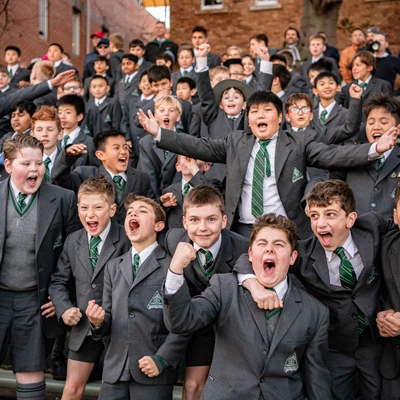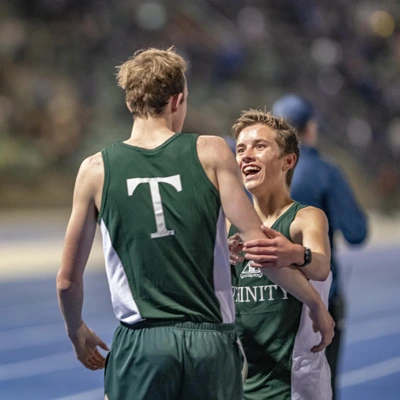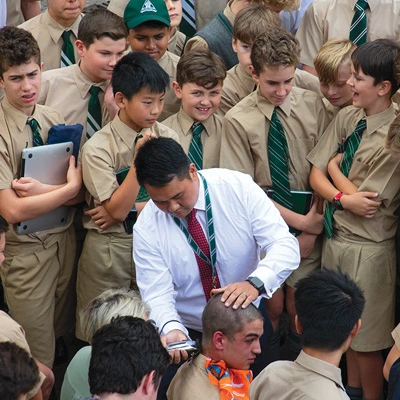Green Patch – sowing the seeds

Sowing the seeds of learning
A mini garden of Eden is taking shape as Trinity primary students become primary producers.
The visionary Green Space Initiative along Seaview Street, Summer Hill, is part of a long-term lesson in sustainability as Junior School boys learn how to care for their own immediate environment as well as the Earth.
Each Year group has been allocated a space around the Junior School to grow vegetables and herbs, and will ultimately eat their own produce after clearing, designing, planting and nurturing their allotted space.
Students turned the first sod in March with the launch of the lunchtime ‘clearing crew’. There was an “overwhelming” response to the call for volunteers to begin removing New Zealand flax, creeping junipers, buxus and tea trees, making way for the productive garden beds to come.
Teachers reported it was hard to get them to stop when the bell rang because they were enjoying it so much.
They have now reached the design stage of the project, with an imminent exhibition of some of their most imaginative ideas.
They are transforming the School’s border from landscaped gardens into productive areas which remain aesthetically attractive, and soon they will see a natural world of their own creation unfold before their eyes.
The boys will be responsible for every stage of the Seven Ps process – from planning, preparing, planting and pampering through to protecting, picking and plating the patch.

“We are giving life to the space,” said specialist environmental educator Melinda Bargwanna.
Four main families of vegetables will be grown using a crop rotation system:
- Legumes, such as beans and peas, which add nitrogen to the soil;
- Leafy greens including kale, broccoli, cauliflowers, spinach, silver beet, cabbages and other heavy feeders;
- Roots, including carrots, parsnips and potatoes – lighter feeders which draw up nutrients from deeper in the soil; and
- Seed fruits, such as tomatoes, eggplant, capsicum, pumpkins and cucumbers.
Resting of the beds in this rotation system will be important. Each bed will undergo a fallow season where a green manure crop will be planted to add nitrogen to the soil. Organic matter to assist with soil structure will be added when the boys cut the growth in half and plough the cuttings and roots back into the soil.
Crop rotation reduces the risk of pests and diseases and maximises soil fertility, reducing the use of pesticides and the addition of inorganic fertilisers.
“If required, our green patch will be protected with organic pest and disease control measures like chilli spray or beer traps for snails,” said Mrs Bargwanna.
“The compost will improve the soil structure and add nutrients to the soil, as will worm tea and the green manure crops.”
Mrs Bargwanna sees her newly created role as sharing the fruits of everything she has learned from the “ultimate landscape architect” – God.
She regards it as the perfect combination of all of her skills – as a university lecturer in Landscape Architecture, the director of a landscape design business, a lover of nature, someone who enjoys working with children, and as a Christian.
“I feel so privileged to be in a school where I can share my love of God through nature,” she said.
“One of my favourite Bible quotes is from Job: speak to the earth and it will teach you.
“I have learned so much about the environment from spending time in nature and marvelling at the details of God’s design. I love watching the way water meanders across the landscape, the combination of the trees, the patterns of soil. He just puts things together perfectly and it’s so inspirational for me as a designer.
“I want to show the students the intricacies of His design and use this to generate their own design ideas.”
Mrs Bargwanna completed a Bachelor of Landscape Architecture at UNSW, where she has since lectured for 27 years.
She also studied then taught at Ryde TAFE’s School of Horticulture for 23 years. Over the past four years she ventured into the online learning world of TAFE Digital’s Natural Environment, teaching landscape design. While lecturing she has also been the director of a landscape design studio.
Between designing and lecturing Mrs Bargwanna volunteered as a scripture teacher for nine years at Burnside Public School in North Parramatta, where her sons, now aged 19 and 17, attended. It provided a nice link with her role as the P&C Landscape Co-ordinator, creating great interactions with students and parents.
Recently Mrs Bargwanna has been surprised by how anxious young people feel about the future of the planet, global warming and environmental degradation.
“I want to teach the boys skills and concepts to give them hope that they can make a difference to current issues, finding solutions and to become world changers,” she said.
“By educating them early and making them environmentally aware we can give them a great head start in learning to live sustainably. I hope this will have a ripple effect on families and communities, and we’ll see some great things come out of our Green Patch Initiative.
“I am optimistic our younger generation will find sustainable solutions not yet thought of, and my hour with the boys each week will be a legacy that impacts their lives in so many ways.”
















